Over the weekend, I got to see a car that overwhelmed me with its sheer presence. Well, I’m not sure if calling it a car is even accurate. Its shape reminded me of a yacht while it had the footprint of a commercial truck. This car was the Mohs Ostentatienne Opera Sedan and it was created by a serial businessman once called “The Wizard of Wisconsin.” It’s one of the most bizarre cars I’ve ever seen in person.
After months of a cold, somewhat miserable winter, temps have risen enough in northern Illinois that my wife and I wanted to take a random day trip somewhere. Our original plan saw us driving out to Kaskaskia, the only part of Illinois that is located west of the Mississippi River. We slept in too late to make it. Instead, we decided to keep our day trip closer to home. As it happened, Sheryl knew about a car museum near Rockford and somehow, even though we’ve been together for years, she’s never taken me there. That finally changed on Saturday when she took me to Historic Auto Attractions in Roscoe, Illinois.
A Different Kind Of Car Museum

This museum isn’t quite like any other that I’ve been to. I’m used to seeing museums filled with movie cars and significant cars throughout history. Wayne Lensing’s Historic Auto Attractions is less about the cars and more about who owned them. The museum has over 80,000 square feet of space and a lot of vehicles, but you’ll quickly notice a theme. Most of the cars were used or owned by former world leaders. Did you know that Nixon had a Chrysler Executive Limousine at some point?

I didn’t until I saw his K-car limo at the museum. Someone also preserved a Mercedes owned by Gorbachev.
Most of the vehicles in the museum make you think “huh, someone decided to keep that car around?” I mean, how about the Checker cab used by Lee Harvey Oswald?

Walk past the collection of world-leader cars and you’ll find yourself in a room full of oddball car builds. This room had a solar car and what looked like a 55-gallon drum turned into a little boat with a baby outboard motor. What drew me in was the car in the center, the one and only 1968 Mohs Ostentatienne Opera Sedan.

Next to it was a one of three 1973 Mohs SafariKar (below).
Both of these cars are absolutely bizarre creations that upon first sight, you might think were shed builds. Look a little longer and you’ll realize that these are more than that. These Mohs cars have a good level of detail to them. They just look like cars out of a low-budget video game.
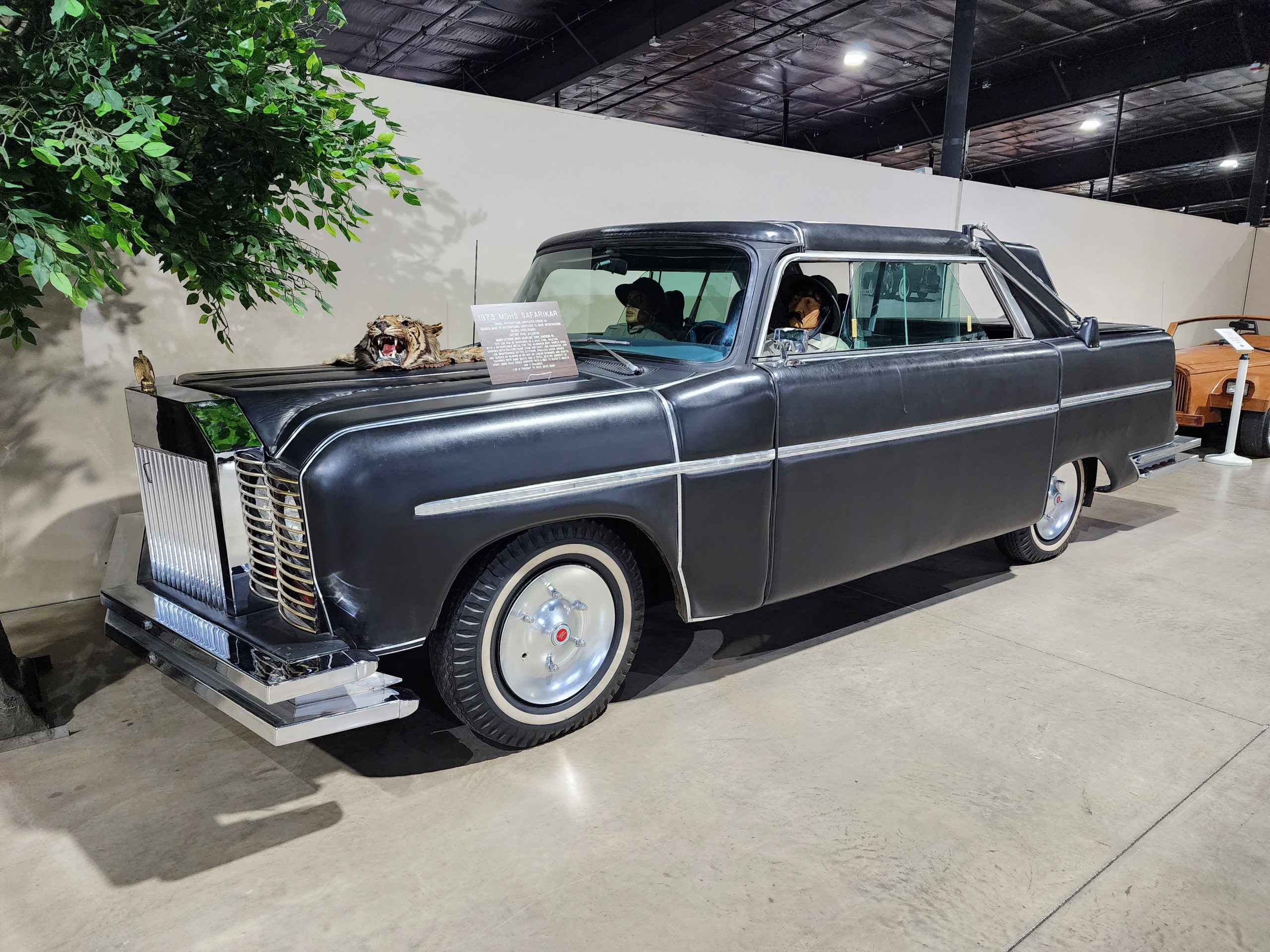
The Wizard of Wisconsin
The mind behind these cars is one Bruce Baldwin Mohs. As Hagerty writes, Mohs was perhaps best described as eccentric, but I’m not sure if that’s even the correct word. Mohs was the kind of guy to take the inventions rattling around in his head and turn them into something real.

A 1981 issue of the Washington Post notes that Mohs was an inventor from a young age and he had a love for motorized contraptions. He was born in 1932 in Madison, Wisconsin, to parents with impressive resumes. His father helped invent the detonation device for a 1,000-pound bomb used in World War I. His mother was an architect. Together, the parents built an empire of sorts in Madison and they were reportedly responsible for a number of the structures built in the city in the era.
This clearly rubbed off on young Bruce Mohs. As a kid, he built rockets and sold them to other kids. Apparently, some of those rockets caught fire, which motivated Mohs to think about ways to make things safer. As the Washington Post writes, Mohs built his first vehicle at 9 years old when he took a three-horsepower engine from his father’s cement mixer and bolted it to a wagon. Mohs’ interest in cars was catapulted when he was 12. For his 12th birthday, Mohs’ father gave him a 1920 Falls 8 racer, a vehicle that was originally built as an Indy racer. Two years later, Mohs got into motorcycles and he built his first scooter.

This kicked off an entire lifetime of inventing where Mohs would create something, get a patent, and license those patents out to manufacturers. A lot of his inventions would have a safety aspect to them. For example, one of Mohs’ inventions was a chemical process patent used in covering television tubes to prevent them from exploding. That invention actually started as an idea to keep car taillights from breaking so easily. In his experiments, Mohs accidentally discovered a new way to bond plastic and glass. As a result, when a tube television falls onto the floor (or you put your foot through it) you can be safe from a total explosion.
Mohs’ list of inventions is reportedly practically endless. In 1950, Mohs built a rubber track snowmobile. In 1958, Mohs invented a scooter that weighed just 40 pounds. Mohs had his name on everything from aluminum bicycle pedals, aircraft parts, a rotating baby stroller, electric scooters, small motorcycles, bicycle sidecars, key cases, and even an amphibious sidecar motorcycle. That last one is something I wish I could own today. Mohs loved motorcycles and boats, so he figured out a way to combine them together by turning a motorcycle sidecar into a detachable mini boat.
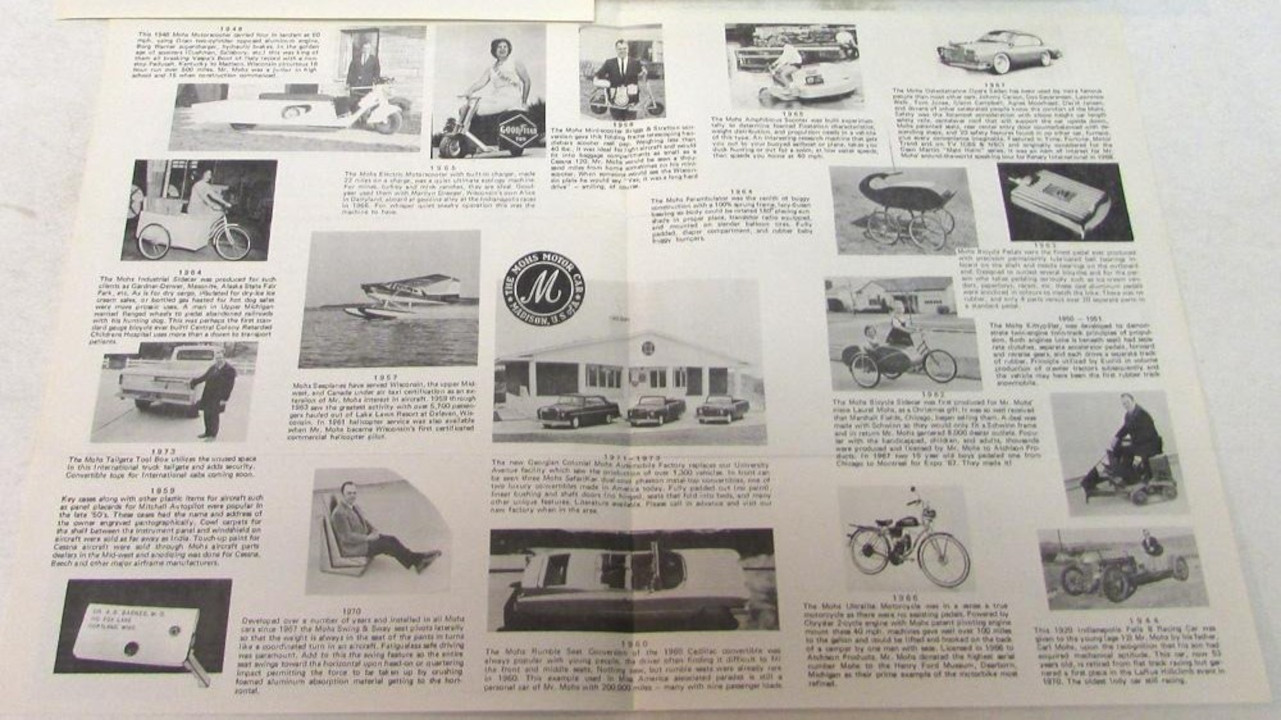
When Mohs’ parents died, he inherited their enterprise. He got a hotel, a restaurant, and other properties out of it. And when he wasn’t tending to the empire, Mohs kept inventing. Mohs was a fan of aviation, too, and when he was in the Air Force, he purchased a Cessna 185 floatplane to use as an air taxi, for excursion flights, and for a charter service. Mohs also became Wisconsin’s first certified commercial helicopter pilot. His aviation exploits fell under the umbrella of the Mohs Seaplane Corporation, though, so would a bunch of Mohs’ inventions regardless if they had anything to do with planes or not.
I think Washington Post sums up the weirdness of Mohs up well:
Depending on the day and his mood, Mohs could have appeared as:
An automobile manufacturer;
A restaurateur and hotel operator;
The president of the commission to celebrate the bicentennial of manned flight;
A longtime provider of mechanical props to Hollywood who has worked with Alfred Hitchcock, among others;
The inventor of the instant milkshake;
A man who worked with the U.S. Army Corps of Engineers to help locate the optimal sites for new islands in Mississippi River reclamation projects;
A big-game hunter and photographer who has traveled in 110 countries;
A man who did infrared photography for NASA’s earth satellite program to help pinpoint satellite trajectories;
The curator of a museum with one of the world’s more unusual collections of vehicles of all types;
The inventor and manufacturer of the Reflecto-strip, used on highways and guardrails on four continents;
The proprietor of a 31-foot scale model of the battleship Wisconsin in which he steams across Lake Mendota.
The Ostentatienne Opera Sedan

When it comes to cars, Mohs decidedly chose to be weird. World Car Guide reportedly described Mohs as an engineer who “designed and build automobiles with a monumental contempt for convention.” The car that we’re talking about today, the Mohs Ostentatienne Opera Sedan, was marketed as: “A totally new concept, the Mohs shares no components or design philosophy with any other car. Nitrogen-filled tires are standard, but the 549-cubic-inch engine is optional for those owners who demand the impossible and expect the improbable.”
As the Washington Post writes, in the mid-1960s Mohs decided to build the most luxurious and safest car to ever hit the road. This was an era where the personal luxury car gained traction and thanks in part to Ralph Nader, America was getting conscious about safety. Mohs responded in 1967 by building a prototype car that he called the Mohs Ostentatienne Opera Sedan.

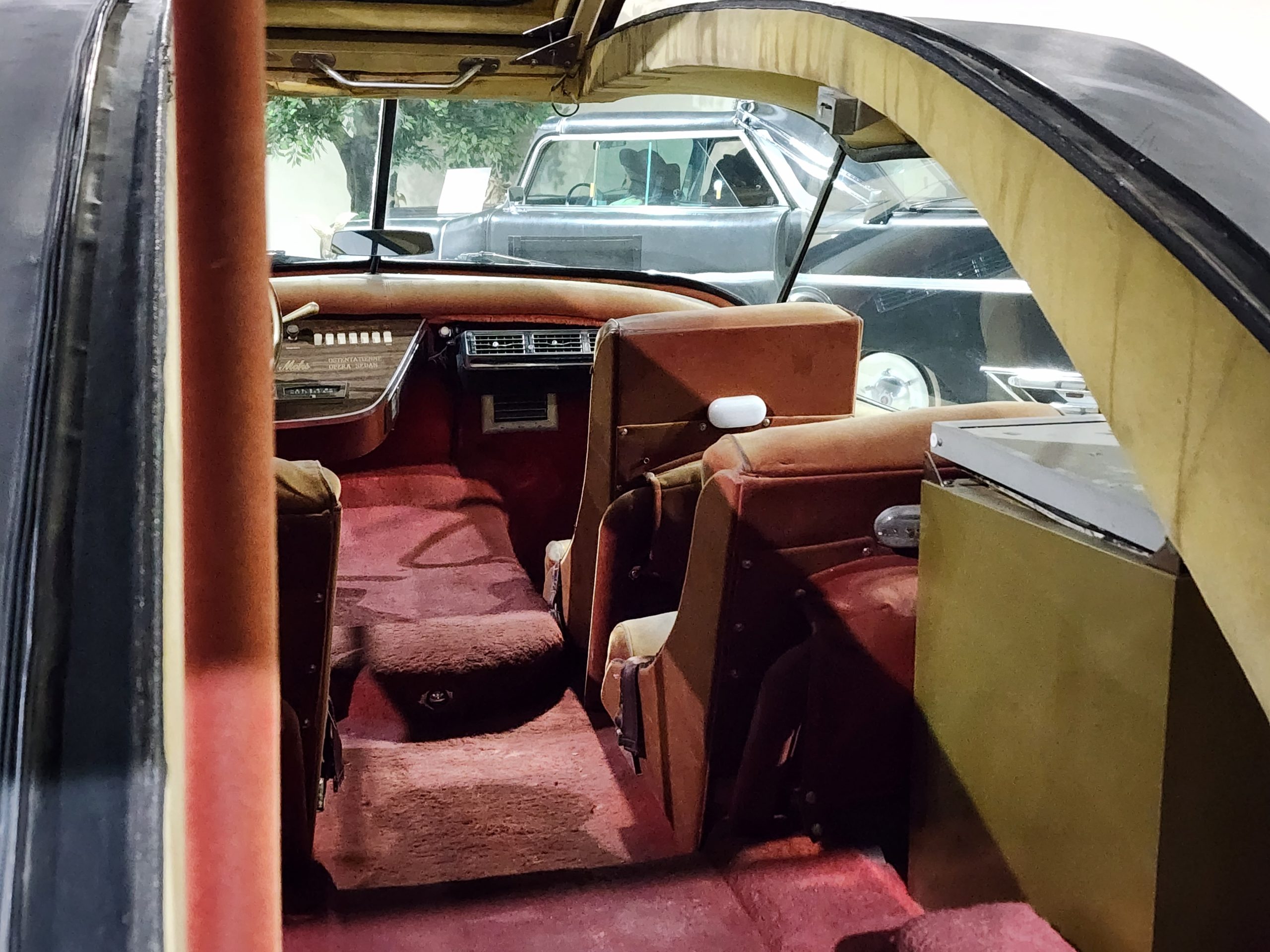

At 20.5 feet long, it’s as long as a camper van. At 5.75 feet tall, it’s as tall as a minivan, and at 7.5 feet wide, it has more in common with an RV than a car. Sometimes journalists like to use the word “massive” to describe things. Well, it’s an accurate word in this case. Oh, and did I mention that it weighs 5,740 pounds?
To build the Ostentatienne Opera Sedan, Mohs got International Harvester to build him a special truck frame. Mounted to that special frame are four 20-inch tall, 7.5-inch wide truck wheels featuring tires filled with pure nitrogen. Mohs boasted the huge tires as offering better safety because they wouldn’t run as hot as smaller tires would. He also claimed that they would last 100,000 miles and that their 74-inch track width was a foot wider than luxury cars of the day. Powering the Ostentatienne Opera Sedan was a 304 cubic inch International V8 making 250 HP, though Mohs touted a 549 cubic inch V8 as the top option.

Mohs’ pursuit for safety led to some interesting choices. He claims that the Ostentatienne Opera Sedan has at least 20 safety features found in no other car. Some of the cars of today still don’t have some of these features. The first thing you’ll probably notice is that the front doesn’t have any doors and the windows do not appear to open. You’d be correct on both counts. Mohs felt that conventional doors and windows are unsafe.
So, there’s just one way to get in and out of the Ostentatienne Opera Sedan and it’s through a giant hatch out back.

By eliminating side doors, Mohs was able to add girders to the sides and roof of the car. These are supposed to protect occupants in a side impact. The roof was also designed to be strong enough to keep the vehicle intact upside-down while not obscuring any outward visibility. It’s unclear whether the hatch would still work when the car was upside down, but redundancy is a windshield that pops open after a crash. Other safety features include bright taillights that are supposed to tilt after a crash and an illuminated airliner-like aisle to walk down. And not really a safety feature, but Mohs said that the hatch would allow the driver to exit the car “erect and with dignity.”
Perhaps the most ambitious safety element is the car’s seating.
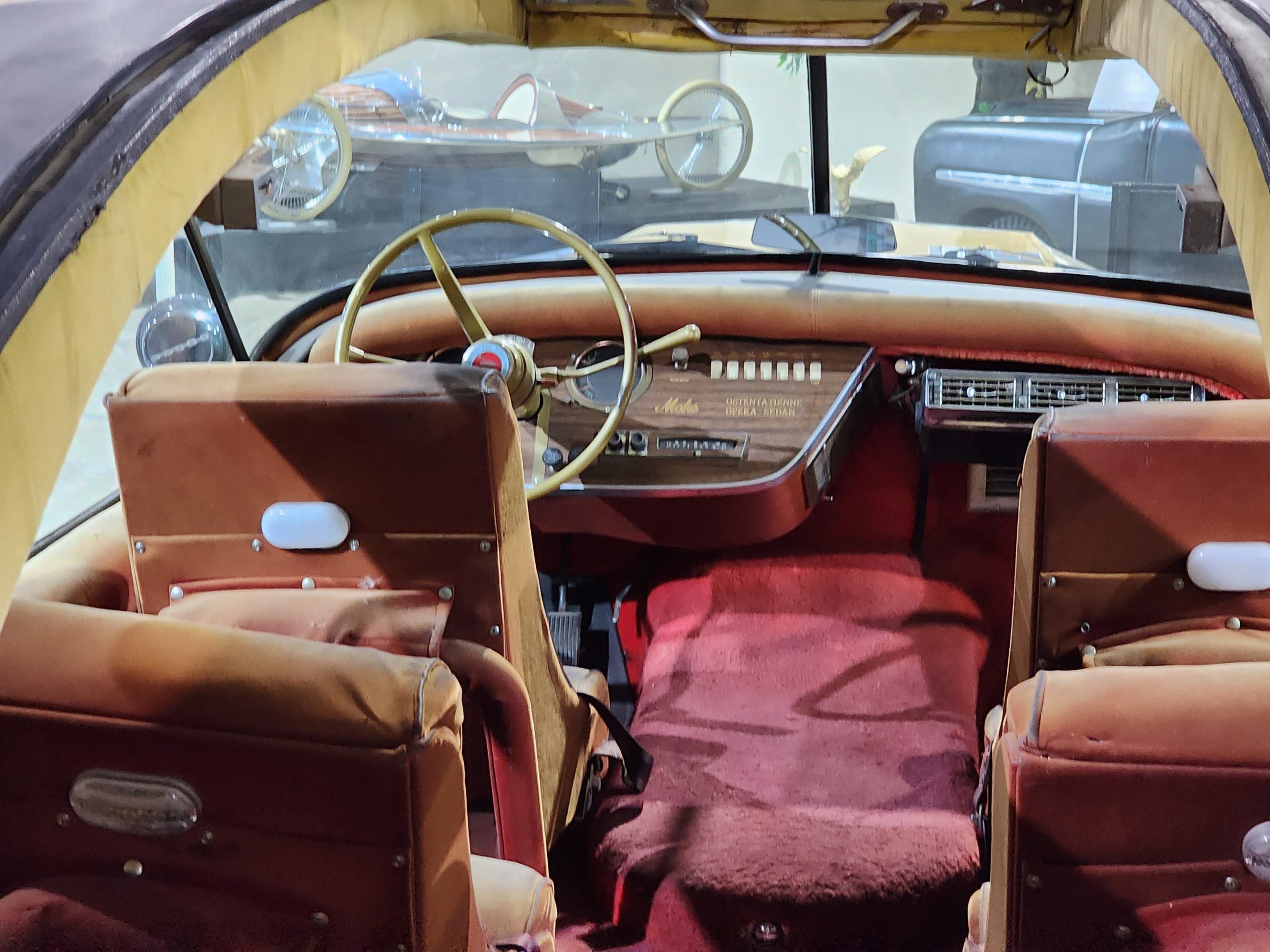
Mohs believed that he had a solution better than airbags. The Ostentatienne Opera Sedan featured seats that swiveled and leaned with centrifugal force. This was supposed to help the vehicle remain comfortable in curves and supposedly would negate the need for airbags by tilting to a horizontal position. Despite the safety theme, the car retained the tubed tires, a truck suspension, and drum brakes. Though, Mohs said that the car was designed so that those brakes would be cooled by the air flowing under the car.


In addition to the safety features, the Ostentatienne Opera Sedan was meant to be the pinnacle of luxury. Mohs advertised options like oriental rugs, walnut wood, 24 ct. gold inlays, velvet upholstery, air horns, a removable skylight, a butane-powered RV furnace, heated water, a refrigerator, and a CB radio. Those features are definitely another way this car was closer to an RV than a car.
Mohs apparently spent $16,000 building the car, or $146,305 today. He offered it up to the public for $19,600 for the base model, or $179,223 today. Mohs said that each Ostentatienne Opera Sedan would be built specifically to its owner’s desires, so the price was pretty fluid.
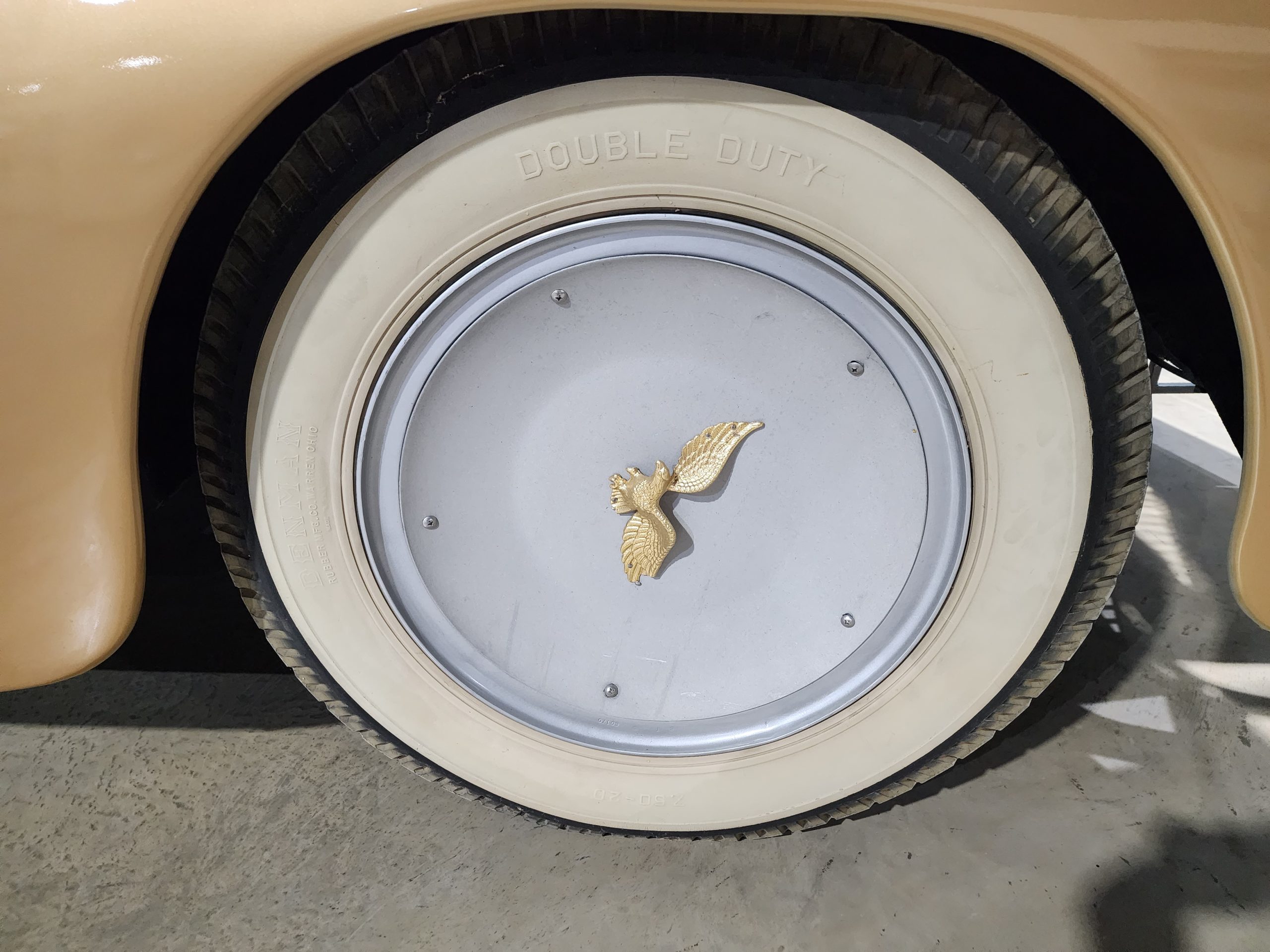
If you wanted the bigger engine, you had to cough up $25,600, or $234,088 today. The car was sold under Mohs Motor Car, a division of Mohs Seaplane Corporation. Mohs found zero takers for the Ostentatienne Opera Sedan and ended up using the sole example as his daily driver and a car to pick up Mohs Seaplane customers from the airport. A number of stars reportedly rode in the car from Joan Crawford to Johnny Carson.
Second Chances

In the 1980s, the car was mothballed and put into storage. In 2008, high school instructor and inventor Fred Beyer found the Ostentatienne Opera Sedan in a sorry state and told Mohs that his students could rebuild it. Mohs gave them the car, and Beyer worked with students from the Freedom High School Automotive Program, the Freedom Auto Club, and the Shawano High School Hot Rod High program to revive the car. Beyer, instructor Jay Abitz, Bob Abitz, Mike Carnahan, and the students spent 16 weeks and 400 hours restoring the car. The students disassembled the car, performed mechanical repairs, detailed the car, and reassembled it. The team had to restore the paint, fabricate panels, and repair decades of rust.
The car was completed in 2009 and has since been featured in Hot Rod magazine, Kustoms, and Hot Rods. It was also at the Wisconsin Automotive Museum in Hartford before making its way down to Illinois. To me, this restored car is as much the crazy work of Mohs as it is the fantastic work of skilled students and their teachers. If you asked me, this looked like it was restored by professionals.

Amazingly, the Ostentatienne Opera Sedan wasn’t Mohs’ only attempt at building cars. In 1973, Mohs managed to build three Mohs SafariKar. These International Travelall-based cars were off-roaders designed to run quietly to be used in African safaris. The idea was that animals get scared by the sounds of a running engine, so Mohs would build a car that ran quietly. It also had rear seats that converted into a bed for when those safaris went into the night.

Adding to this car’s weirdness is its aluminum-tungsten alloy bulkheads with steel outriggers. These hold body panels that consist of 40 yards of Naugahyde and thick padding. And of course, since this is a Mohs car, getting in and out is weird. The doors are on horizontal tracks and expand out to let you get in. The windows open on sliders and it has a convertible top, too. Something that I was confused by was the fact that it had the kinds of plastic bucket seats that you’d find in desert racers. I thought that these were just part of a lazy restoration job but apparently, that’s what Mohs offered from the factory.

The SafariKar is probably worth its own deep dive, but perhaps the craziest part is that Mohs actually managed to sell three of them. Of that, just two survive today. Sadly, Mohs himself passed on into the next world in 2015, but at least he got to see his Ostentatienne Opera Sedan restored back to its glory.
If you want to see these cars, head down to Historic Auto Attractions in Roscoe, Illinois. The museum is a hole-in-the-wall sort of place and you’ll get through it in maybe two hours, tops. However, I think it’s totally worth the $28 adult admission.
Support our mission of championing car culture by becoming an Official Autopian Member.

-
I Caught A Cold Visiting America’s Largest Train Museum. Here’s Why It Was Totally Worth It
-
How A Mysterious Company Turned Semi Trucks Into Campers In The 1980s
-
The Most Powerful Locomotive In America Was So Loud It Was Banned From Cities And So Hot It Melted Pavement. Here’s A Close Look
-
I Found A Century Of Incredible Transit Bus History At A Train Museum




Amazing article…whoa, the 1st time I read this when it was published I didn’t notice that bit about the Checker and Lee Harvey Oswold. I’ve actually already been reading a lot about Checker lately and it’s fascinating…I love this only remaining Art-Deco ’39 Checker cab
https://www.hagerty.com/media/automotive-history/this-last-surviving-1939-art-deco-checker-marks-the-high-point-of-taxi-design/
Plastic bucket seats make sense if you have a rifle, nothing to get snagged on.
I know it’s past his presidential era, but goddamn if that Executive K-Car isn’t the most Nixon sedan that ever Nixoned
I love the amphibious motorcycle sidecar! Which, by the way, was characterized incorrectly as an “amphibious sidecar motorcycle.” That may sound like picking nits, but think about it – the second description implies that you can just ride the whole thing straight into the water. The actual design has only the sidecar as amphibious! Which, in my imagination, makes the sidecar a very specific kind of escape pod. Picture this: a motorcycle, careening out of control towards a lake; the driver, realizing that death by drowning awaits both of them only seconds away, selflessly pulls the yellow-striped ejection handles, whereupon a series of explosive bolts separates the side-pod, launching it safely into the water as the driver of the now sidecar-less motorcycle plunges beneath the waves to meet his watery fate. Sure, there may be photos of driver and rider cooperating to remove the sidecar and place it in the water, but that’s just a terrible story and really selfish on the part of the passenger – “Hey, drive my one-person boat to the water and then help me get in. Oh, and wait on shore until I’m done, because you’re my ride home.”
I’ve been to this museum! It’s so gloriously weird. And I’ve always been fascinated by the Mohs cars … especially the upholstered SafariKar. Thanks for the reminder, Mercy!
I loved looking at those cars and so many more when I visited that museum a few years ago. It was really dim during my last visit so my photos were all really dark. I’d love to go back again seeing how they must have turned the lights up.
My other problem is that I read all the information about every exhibit at a museum and they have a lot of literature on display, and I take way too long to make my way through.
I love love love all the Mohs cars!!
So much unrestrained madness, yet they feel like they have some deeper purpose.
I always thought of David Tracy as a similar character, like Mohs’ hardscrabble, factory-working cousin.
I believe I saw a Safarikar at the Imperial Palace car museum in Vegas years ago.
You did. I remember the same thing. They’re definitely … odd in person, more so than the photos and words would have you believe. And I’m glad they exist.
Man I LOVE weird cars and especially Mohs. Thanks for sharing.
That car is something else. And today I learned there was a portion of Illinois west of the Mississippi River.
I couldn’t let Kaskaskia go. After looking at the satellite view, it is quite obvious what happened there. That is fluvial morphology in action as the river shifted.
To add to the fun facts, Kaskaskia is the only current or former state capital to exist in an exclave.
It looks like the river just decided to go that way now, but it was mostly a human fuck-up at the time. They clear cut the trees that held the natural levees separating the Mississippi and Kaskaskia river. When the great flood of 1881 dumped into the Mississippi up by St. Louis it “don’t mind if I do”ed its way straight through.
What a fascinating car and man, great article.
This was a fun article. Everything today is very homogenized. Nice to briefly travel back to a time where there was so much possibility.
Few eccentrics are well off enough to have the opportunity to express themselves and not be destitute. Thank goodness for wealthy parents. We can thank them for the opportunity to enjoy the fruit of their son’s creativity.
Over the top, massive, stupid level of luxury, completely impractical. I want one.
And this, ladies and gentlemen, is why we have car designers.
It has a resemblance to The Homer:
https://www.youtube.com/watch?v=WPc-VEqBPHI
It is still a design statement, it speaks for itself the statement is NO!
There is some beauty in it, just because it actually was made and not just a threat on paper. I’m reminded of that saying about politicians, ugly buildings and whores.
If my cats are any indication, every predator within ten miles would come running to claw the sh*t out of that Safarikar’s Naugahyde panels, affording the guests an excellent opportunity to take pictures.
FWIU the Ostentatienne Opera Sedan was technically on offer until at least the mid ’70s and I find it amazing that nobody at all – not the Sultan of Brunei, not Liberace, not anyone – went through with actually ordering one.
If it’s too tasteless for Liberace, you have to ask yourself if you’ve gone too far.
You owe me, for making me spew beer across the kitchen!
Damn shame it’s not offered today, there must be a billionaire that needs one!
That is correct! Sadly, I couldn’t find a high-res full spread of the brochure, but an image included in this article is a brochure from the mid-70s that advertised both the Opera Sedan and the SafariKar at the same time.
Mohs tried to give his car company some cred by saying that he had 1,200 vehicles on the road, but those were certainly his other projects like the scooters, sidecars, and minibikes.
Breathtaking!
Starting with the name, this car seems to be intentionally over-the-top and poking fun at its own existence — and quite possibly those who might want to buy it and weren’t in on the joke. It’s awesome!
Oh, those patented “sealed beam tail-lamps” are just red sealed-beam lams in the same dual headlight mounts used for the headlights… which are parts-bin specials used on International and other trucks and buses..
This was The Homer before its time…
So basically Mohs was the Aznom of its day. You know what, I think I’ll take the Mohs. Actually, scratch that, Tropiclassic all day any day.
That Naughahide Safarikar is also super wild. These both are on the list of crazy cars for sure.
So the acronym for Mohs Blah Blah Sedan is MOOS. I have got to see this in person so thanks for the trip tip!
I had wondered where the Ostentatienne Opera Sedan ended up after its restoration. Thanks! For anyone wanting to know more, the modestly-named autobiography The Amazing Mr. Mohs: Titled as the Movie of the Same Name is a great read.
Among my prized possessions is a printing block of the Mohs logo used in making the company’s ads:
https://live.staticflickr.com/7408/27192365776_0a2e96283e_c.jpg
OH THAT’S SO COOL!
I’m glad I don’t own that, I’d stamp that on everything.
I use it occasionally but it doesn’t work all that well as a standalone stamp. It really needs a proper press.
https://live.staticflickr.com/65535/52808453989_5b0163163d_c.jpg
Moh’s uncle Frederic was the inventor of a highly regarded skin cancer surgery, according to the Google.
A surgery I’m undergoing for the second time on Friday. Florida’s a wonderful place to live, don’t let anyone tell ya different.
Yes, unfortunately I know. It’s been 7-8 years and the huge scar has faded a lot but it’s still present. But no more skin cancer!